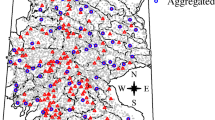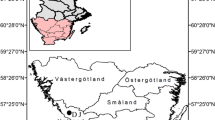Abstract
In order to predict the impact of future climate warming on trees it is important to quantify the effect climate has on their development. Our understanding of the phenological response to environmental drivers has given rise to various mathematical models of the annual growth cycle of plants. These models simulate the timing of phenophases by quantifying the relationship between development and its triggers, typically temperature. In addition, other environmental variables have an important role in determining the timing of budburst. For example, photoperiod has been shown to have a strong influence on phenological events of a number of tree species, including Betula pubescens (birch). A recently developed model for birch (DORMPHOT), which integrates the effects of temperature and photoperiod on budburst, was applied to future temperature projections from a 19-member ensemble of regional climate simulations (on a 25 km grid) generated as part of the ENSEMBLES project, to simulate the timing of birch budburst in Ireland each year up to the end of the present century. Gridded temperature time series data from the climate simulations were used as input to the DORMPHOT model to simulate future budburst timing. The results showed an advancing trend in the timing of birch budburst over most regions in Ireland up to 2100. Interestingly, this trend appeared greater in the northeast of the country than in the southwest, where budburst is currently relatively early. These results could have implications for future forest planning, species distribution modeling, and the birch allergy season.







Similar content being viewed by others
References
Alig RJ, Adams D, McCarl B (2002) Projecting impacts of global climate change the US forest and agricultural sectors and carbon budgets. Forest Ecol Manage 169:3–14
Berry PM, Dawson TP, Harrison PA, Pearson RG (2002) Modelling potential impacts of climate change on the bioclimatic envelope of species in Britain and Ireland. Glob Ecol Biogeogr 11:453–462
Brachi B, Aimé C, Glorieux C, Cuguen J, Roux F (2012) Adaptive value of phenological traits in stressful environments: predictions based on seed production and laboratory natural selection. PLoS ONE 7(3):e32069. doi:10.1371/journal.pone.0032069
Bronaugh D (2013) PCICt: implementation of POSIXct work-alike for 365 and 360 day calendars. R package version 0.5-3. http://CRAN.R-project.org/package=PCICt
Buisson L, Thuiller W, Casajus N, Lek S, Grenouillet G (2010) Uncertainty in ensemble forecasting of species distribution. Glob Chang Biol 16:1145–1157
Caffarra A, Donnelly A, Chuine I, Jones M (2011a) Modelling the timing of Betula pubescens budburst. I. Temperature and photoperiod: a conceptual model. Clim Res 46:147–157
Caffarra A, Donnelly A, Chuine I (2011b) Modelling the timing of Betula pubescens budburst. II. Integrating complex effects of photoperiod into process-based models. Clim Res 46:159–170
Caffarra A, Rinaldi M, Eccel E, Rossi V, Pertot I (2012) Modelling the impact of climate change on the interaction between grapevine and its pests and pathogens: European grapevine moth and powdery mildew. Agric Ecosyst Environ 148:89–101
Carroll E, Sparks T, Donnelly A, Cooney T (2009) Irish phenological observations from the early 20th century reveal a strong response to temperature. Biol Environ Proc R Ir Acad 109:115–126
Chmielewski FM, Rötzer T (2001) Responses of tree phenology to climatic changes across Europe. Agric For Meteorol 108:101–112
Chuine I (2000) A unified model for budburst of trees. J Theor Biol 207:337–347
Chuine I, Beaubien EG (2001) Phenology is a major determinant of tree species range. Ecol Lett 5:500–510
Chung U, Mack L, Yun JI, Kim S-H (2011) Predicting the timing of cherry blossoms in Washington DC and Mid-Atlantic States in response to climate change. PLoS One 6(11):e27439
R Core Team (2012) R: a language and environment for statistical computing. R Foundation for Statistical Computing, Vienna, Austria. ISBN 3-900051-07-0, http://www.R-project.org/
Donald P, Bekhuis J (1993) Mediteraneann gull Larus melanocephalus. In: Gibbons DW, Reid JW, Chapman RA (eds) The New Atlas of breeding birds in Britain and Ireland 1988–1991. Poyser, London, pp 200–201
Donnelly A, Salamin N, Jones MB (2006) Changes in tree phenology: an indicator of spring warming in Ireland? Biol Environ Proc R Ir Acad 106(1):47–55
Donnelly A, Cooney T, Jennings E, Buscardo E, Jones M (2009) Response of birds to climatic variability; evidence from the western fringe of Europe. Int J Biometeorol 53:211–220
Donnelly A, Caffarra A, Kelleher CT, O’Neill BF, Diskin E, Pletsers A, Proctor H, Stirnemann R, O’Halloran J, Peñuelas J, Hodkinson TR, Sparks T (2012) Surviving in a warmer world: environmental and genetic responses. Clim Res 53:245–262
Eccel E, Rea R, Caffarra A, Crisci A (2009) Risk of spring frost to apple production under future climate scenarios: the role of phenological acclimation. Int J Biometeorol 53:273–286
Emberlin J, Detandt M, Gehrig R, Jaeger R, Bolard N, Rantio-Lehtimäki A (2002) Responses in the start of Betula (birch) pollen seasons to recent changes in spring temperatures across Europe. Int J Biometeorol 46(4):159–170
Gleeson E, Donnelly A, Ní Bhroin A, O’Neill BF, Semmler T, McGrath R (2013) A comparison of spring tree phenology with a range of meteorological parameters. Biol Environ Proc R Ir Acad 113(B):47–56. doi:10.3318/BIOE.2013.06
Grolemund G, Wickham H (2011) Dates and times made easy with lubridate. J Stat Softw 40(3):1–25. URL http://www.jstatsoft.org/v40/i03/
Gu L, Hanson P, Mac Post W, Kaiser DP, Yang B, Nemani R, Pallardy S, Meyers T (2008) The 2007 Eastern US spring freeze: increased cold damage in a warming world? Bioscience 58:253–262
Haylock MR, Hofstra N, Tank AMGK, Klok EJ, Jones PD, New M (2008) A European daily high-resolution gridded dataset of surface temperature and precipitation. J Geophys Res Atmos 113:D20119. doi:10.1029/2008JD10201
Hewitt CD, Griggs DJ (2004) Ensembles-based predictions of climate change and their impacts. EOS 85:566
Hijmans RJ, van Etten J (2013) Raster: geographic data analysis and modeling. R package version 2.1-16 http://CRAN.R-project.org/package=raster
Hijmans RJ, Williams E, Vennes C (2012) Geosphere: spherical trigonometry. R package version 1.2-28. http://CRAN.R-project.org/package=geosphere
IPCC (2007) Climate change 2007: impacts, adaptation and vulnerability. Contribution of Working Group II to the Fourth Assessment Report of the Intergovernmental Panel on Climate Change. Parry ML, Canziani OF, Palutikof JP, van der Linden PJ, Hanson CE (eds) Cambridge University Press
Kurz WA, Dymond CC, Stinson G, Rampley GJ, Neilson ET, Carroll AL, Ebata T, Safranyik L (2008) Mountain pine beetle and forest carbon feedback to climate change. Nature 452:987–990
Morin X, Viner D, Chuine I (2008) Tree species range shifts at a continental scale: new predictive insights from a process-based model. J Ecol 96:784–794
Myking T, Heide OM (1995) Dormancy release and chilling requirement of buds of latitudinal ecotypes of Betula pendula and Betula pubescens. Tree Physiol 15:697–704
Nakicenovic N, Alcamo J, Davis G, de Vries B, Fenhann J, Gaffin S, et al. (2000) Special report on emissions scenarios: a special report of Working Group III of the Intergovernmental Panel on Climate Change (No. PNNL-SA-39650). Pacific Northwest National Laboratory, Richland, WA (US), Environmental Molecular Sciences Laboratory (US)
Newnham RM, Sparks TH, Skjøth CA, Head K, Adams-Groom B, Smith M (2013) Is the timing of birch pollen release in the UK approaching its limit? Int J Biometeorol 57:391–400
O’Connor B, Dwyer E, Cawkwell F, Eklund L (2012) Spatio-temporal patterns in vegetation start of season across the island of Ireland using the MERIS Global Vegetation Index. ISPRS J Photogramm Remote Sens 68:79–94
Pagel J, Schurr FM (2012) Forecasting species ranges by statistical estimation of ecological niches and spatial population dynamics. Glob Ecol Biogeogr 21:293–304
Pearson RG, Dawson TP (2003) Predicting the impacts of climate change on the distribution of species: are bioclimate envelope models useful? Glob Ecol Biogeogr 12:361–371
Richardson DS (2001) Measures of skill and value of ensemble prediction systems, their interrelationship and the effect of ensemble size. Q J R Meteorol Soc 127:2473–2489
Smiddy P, O’Sullivan O (1998) The status of Little Egret Egretta garzetta in Ireland. Ir Birds 6(2):201–206
Toth Z, Kalnay E (1993) Ensemble forecasting at nmc: the generation of perturbations. Bull Am Meteorol Soc 74:2317–2330
Van Der Linden P, Mitchell JFB (eds) (2009) ENSEMBLES: climate change and its impacts: summary of research and results from the ENSEMBLES project. Met Office Hadley Centre, Exeter, UK
Walsh S (2012) Met Eireann Climatological Note No.14: a summary of climate averages for Ireland 1981–2010
Walther GR, Post E, Convey P, Menzel A, Parmesan C, Beebee TJC, Fromentin J-M, Hoegh-Guldberg O, Bairlein F (2002) Ecological responses to recent climate change. Nature 416:389–395
Zhang H, Pu Z (2010) Beating the uncertainties: ensemble forecasting and ensemble-based data assimilation in modern numerical weather prediction. Adv Meteorol 2010:432160. doi:10.1155/2010/432160
Ziello C, Sparks TH, Estrella N, Belmonte J, Bergmann KC et al (2012) Changes to airborne pollen counts across Europe. PLoS ONE 7(4):e34076
Acknowledgements
The authors would like to express their gratitude to the Irish Environmental Protection Agency (EPA) for providing financial assistance for this work, under the STRIVE programme, project number 2007-CCRP-2.4, Climate change impacts on phenology: implications for terrestrial ecosystems. We also acknowledge the ENSEMBLES project, funded by the European Commission’s 6th Framework Programme through contract GOCE-CT-2003-505539 and Met Éireann for the use of Valentia Observatory phenological records.
Author information
Authors and Affiliations
Corresponding author
Rights and permissions
About this article
Cite this article
Caffarra, A., Zottele, F., Gleeson, E. et al. Spatial heterogeneity in the timing of birch budburst in response to future climate warming in Ireland. Int J Biometeorol 58, 509–519 (2014). https://doi.org/10.1007/s00484-013-0720-5
Received:
Revised:
Accepted:
Published:
Issue Date:
DOI: https://doi.org/10.1007/s00484-013-0720-5




